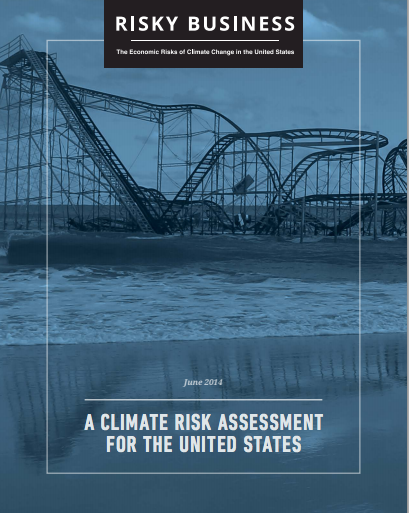Perhaps it was the New York Stock Exchange under water after Hurricane Sandy? Or a polar vortex of a winter that froze the eastern seaboard? Whatever the cause, it appears some Wall Street power brokers are convinced the financial risks of climate change are finally too big to be ignored. Their conclusion? A report released today entitled Risky Business: The Economic Risks of Climate Change to the United States.

Title page from a new report entitled, \”Risky Business.\”
The report uses a risk-assessment approach to outline the impact that climate change has had already and will have on investors’ pocketbooks. The project was co-chaired by billionaire and climate change foe Tom Steyer, former U.S. Treasury Secretary Hank Paulson, and former New York City Mayor Michael Bloomberg. Committee members include former Secretary of State George Shultz and former U.S. Secretary of the Treasury Robert Rubin, among others.
The risk assessment concludes that the financial risks of inaction are greater than the risks of action. The report focuses on three areas that it says present the clearest and most economically significant risks:
- rising sea levels and damage to coastal infrastructure
- changes in energy demand and agricultural production
- impact of higher temperatures on labor productivity and public health
Explaining that “future risks are directly tied to present decisions,” the report makes it clear that policy changes need to be made today in order to avoid steep payments in the future.
In some ways, climate change is like an interest-only loan we are putting on the backs of future generations: They will be stuck paying off the cumulative interest on the greenhouse gas emissions we’re putting into the atmosphere now, with no possibility of actually paying down that “emissions principal.”
The report calls on the business and investment community in this country to put aside short term thinking and look to the longterm to “lead the way in helping reduce climate risks.”
The business world is full of climate change doubters, the report acknowledges. The goal is not to confront them, or persuade, but to put financial risk at the center of the equation and to take out an insurance policy in case the doubters are wrong.
The report quotes Secretary of State George Shultz in an interview with Scientific American, (and he said the same at the Vail Energy Forum earlier this year):
Rather than go and confront the people who were doubting it and have a big argument with them, we’d say to them: Look, there must be, in the back of your mind, at least a little doubt. You might be wrong, so let’s all get together on an insurance policy.
Using a financial argument to convince others that action on environmental issues is needed may be a new trend. Take Mark Tercek, the head of the Nature Conservancy and a former partner at Goldman Sachs. As the New Yorker reported earlier this year, Tercek thinks convincing companies of the financial logic of cleaner, greener production will be far more successful than feel-good environmental conservation. “Retail consumerism,” i.e. teaching people to be green, is not what he’s all about, according to the New Yorker.
With the help of sound metrics drawn from the world of finance—“a higher level of accountability,” in his words—some of the ecological harm caused by the very same corporations can be undone. Nudging big business in a green direction, he believes, can do far more good than simply cordoning off parcels of Paradise.
A trend, but maybe not such a new trend. Back in 1994, British consultant John Elkington coined the term “triple bottom line,” arguing that modern day industry should consider three separate bottom lines in their business strategies: profit, people and the planet.
The triple bottom line (TBL) thus consists of three Ps: profit, people and planet. It aims to measure the financial, social and environmental performance of the corporation over a period of time. Only a company that produces a TBL is taking account of the full cost involved in doing business.
The Economist reports that the idea enjoyed some popularity at the turn of the century, but hasn’t really caught on widely, ad the three separate ledgers “don’t really add up.” Perhaps, though, as the risks and costs of climate change become more apparent, those lines will draw closer to each other.








